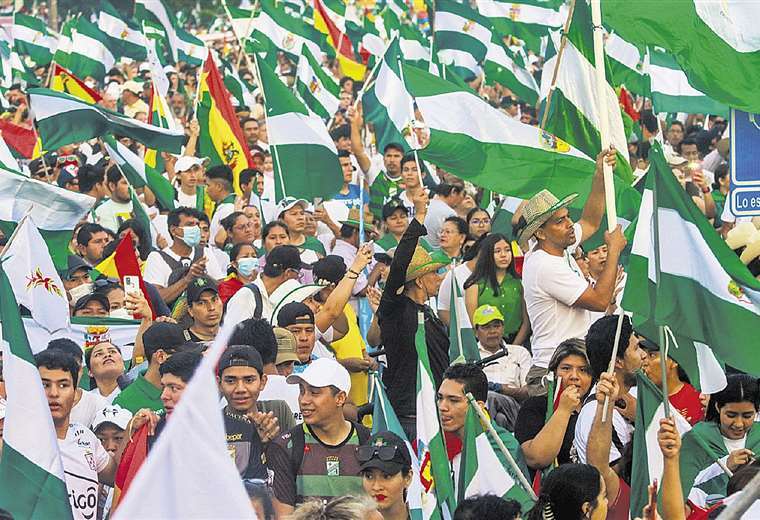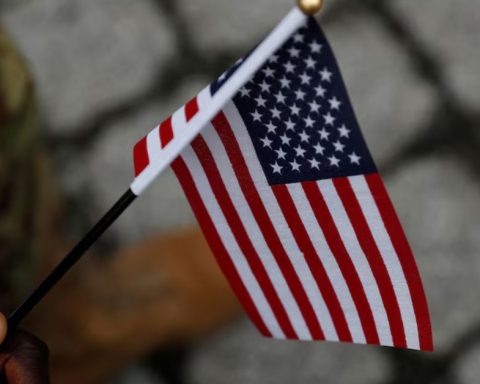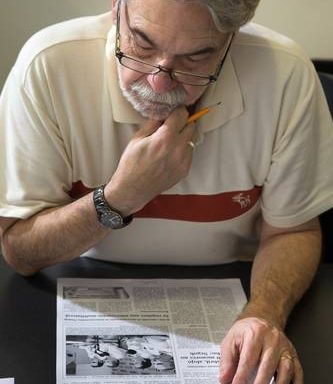The Prosecutor’s Office will investigate three of the Santa Cruz leaders who promoted the 36-day strike. One of them is Vicente Cuéllar, the rector of the University Autonomous Gabriel René Moreno (Uagrm), who demanded respect for the protest and, therefore, “prevent this right from being prosecuted.”
Meanwhile, the Ministry of Economy, through a statement, warned that the monthly allocations corresponding to the transfer of tax co-participation resources will decrease due to the strike. The government report came after the alert from the university about to the lack of resources to close the end-of-year budget.
Meanwhile, the Ministry of Economy reported on one of the effects of the strike, linked to resource transfer resource reductionsa universities and municipalities.
“Every time economic activity stops, such as the strike carried out in Santa Cruz, headed by authorities from the UAGRM and the Civic Committee for Santa Cruz, there are economic losses causing less transfer of resources to municipalities and universities, as well as the attention of services for the benefit of the population”, the report states.
Shortly before, the administrative director of the University, Oscar Nogales, expressed his concern about these reductions. and the absence of disbursements for that this entity can close the year.
“We have reached December and we do not have enough to cover salaries. This situation is due to situations outside the University. We have a decrease the corresponding tax co-participation incomes to the month of November,” Nogales said at a press conference.
He also expressed his concern about the “non-disbursement” of these resources for the months of October and November. “Now we have already made the application for December”, pointed out the authority.
The Government avoids referring to the origin of the conflict. Between July 2021 and November 2022, it issued three supreme decrees with different dates for the Population and Housing Census that allows the redistribution of resources to the regions and the reallocation of parliamentary seats based on population. The last one, 4824, issued on November 14 by President Luis Arce, contemplates the great national survey for March 23, 2024. The decree was elevated to the rank of law, at the request of the massive Santa Cruz council on November 13.
In order to define the date of the census, the redistribution of resources and the reallocation of parliamentary seats, the Inter-institutional Commission of Santa Cruz (made up of the UAGRM, the Civic Committee, the Governor’s Office and mayors’ offices) held 14 summits to demand information from the National Institute of Statistics (INE) and the Government, three citizen strikes and two councils, mentioned the constitutional lawyer and legal adviser to the Commission, José Luis Santistevan.
For his part, the rector of the UAGRM announced that he will evaluate, in the course of the next few days, with the Inter-institutional Committee the legal defense strategy and tensions that still remain after the conflict over the census.
“We hope that justice acts impartially. There has been a town that has completed an indefinite strike, product of the mandate of a council. There has been a parallel council, organized by the social movements that we respect and there has also been a siege of Santa Cruz that has deprived many citizens of having access to food, not only in this department,” he said.
In this context, Cuéllar also drew attention to the attacks on journalists and the reports of police abuse. “When talking about processes, an objective assessment must be made. Obviously, not the executive branch who has to make this objective assessment of some crimes, if they had been committed. The call to do so is the Judicial Branch, which must demonstrate its impartiality, ”he pointed out to insist on the“ contradiction of judicializing the protests ”.
The president, Luis Arce, finally promulgated on Friday, Law 1492 on the Application of the results of the Population Census and Housing in the financial and electoral spheres, la norm that was demanded in the town hall of November 13, the most massive in the history of Santa Cruz.
The norm, although it establishes the date of the survey for March 23, 2024, reflects the government promises of the redistribution of resources from September 2024, when the National Statistics Institute (INE) Present the population results. More money for municipalities with more inhabitants.
These same data must be delivered to the Supreme Electoral Tribunal (TSE) for the reallocation of seats in the Legislaturethis being the second promise of the Executive and which was not incorporated into Decree 4824, on which the new law that put an end to the conflict was based.
Arce said that “a right-wing law” was not approved and lashed out at the people who led the protest for alleged crimes committed in that context. “Of course, the crimes that have been committed cannot remain in impunity”, he remarked in the message broadcast on Friday on television
The State Attorney General’s Office admitted last week three complaints against the governor of Santa Cruz, Luis Fernando Camacho, the rector Cuéllar, and the president of the Civic Committee, Rómulo Calvo, “for the violence of the 36-day strike due to the census.”
“These complaints will be processed. They will be transferred to La Paz or received their declarations in Santa Cruz”, Lanchipa reported.
“We want justice for the four deceased. This violation of rights cannot go unpunished. We are not going to give up on this case; We will ask for justice. These gentlemen who have wanted to destabilize our President They have to be brought to justice.” announced Senator Virginia Velasco (MAS), one of the legislators who promoted the Census Law despite the opposition of the parliamentarians of the so-called ‘Evista wing’.
The Minister of Government, Eduardo Del Castillo, was in Santa Cruz this weekend. “The only thing that has generated this strike is the loss of human lives and hundreds and thousands of wounded in the department of Santa Cruz. No crime that has been committed in the 36 days of strike, from this forced strike will remain in impunity and we will continue to investigate in accordance with current legal regulations, “said the authority.
The bishops in the conflict for the census:
Luis Fernando Camacho
Governor of Santa Cruz
He is the governor of the political opposition to the MAS government. During the prolonged strike in Santa Cruz, he defended the decisions made in the councils and is one of the promoters of the federalist project. He is in the government’s crosshairs for his management and accumulates about seven legal cases against him.
Vincent Cuellar
Rector of the UAGRM
He was the most notorious leader of the Interinstitutional Committee. He made the Census Law viable with MAS legislators. He defended the right to protest, which was questioned by the government and was later accused of the strike. The accusation against him is in the Prosecutor’s Office. He led the group of experts who advocated carrying out the census in 2023.
Romulo Calvo
President of the Committee for Santa Cruz
During the entire time the strike lasted at home due to judicial restrictions. There he set up a press point from where he issued daily pronouncements and received the support of mayors and social organizations from the rest of the country. Next year he will conclude his management at the institution. His house was attacked after the strike.
Stello Cochamanidis
Vice President of the Committee for Santa Cruz
Together with Fernando Larach, the first vice president of the civic groups coordinated with the neighbors the pressure measures and the installation of the common pots. He had a harsh exchange of words with the Vice Minister of Autonomies, Álvaro Ruiz in an attempt to dialogue. Deputy Rolando Cuellar (MAS) said that the civic is a foreigner.
Jose Luis Santistevan
Advisor to the Interinstitutional Committee
It was part of the municipality of Santa Cruz de la Sierra. From there he made proposals to President Luis Arce, but they were not attended to. He then went to the municipality of Porongo and supported the Inter-Institutional Committee. In October he anticipated that, if the census calendar was not readjusted by November, the 2023 census was no longer possible.
Reinerio Vargas
UAGRM Vice Chancellor
The academic authority was an active part of the Mobilization Committee of the Gabriel René Moreno Autonomous University (Uagrm) and promoted mobilizations to support the measure. He demanded and mobilized to lift the blockade on the landfill due to health risks. He claimed to be consulted when the strike ended.
Manuel Saavedra
Councilmember for Democrats
Together with several of his opposition colleagues, he made several complaints against the mayor Jhonny Fernández and against the police officers who transported tear gas or who stayed in municipal schools. On her side, councilor Lola Terrazas (CA) questioned Arce about the arguments she used to postpone the census.
George Richter
Spokesperson for the Presidency
The first interlocutor. In April 2022, he assured that the census was guaranteed for this year; he even stated that the statistical cartographic update would be finished in August. After the postponement of the census, he demanded a technical proposal from the UAGRM. At the end of the conflict, he was no longer a voice in the dialogue with Santa Cruz.
Johnny Omar Chavez
Santa Cruz Police Commander
He was not visible during the days of the conflict, except when he read a statement following the complaint of a woman who suffered from tear gas that affected her daughter. The Police were questioned for repressing those who complied with the strike and blocked, but the critics speak of the fact that the uniformed men protected the MAS shock groups.
alvaro ruiz
Vice Minister of Autonomies
He was part of the technical team that defended the census calendar in 2024. He was an active part of the process that lasted for more than four months with the technical tables and sued the Gabriel René Moreno Autonomous University to present the proposal to shorten the times. He secured the census in 2024 since August.
Johnny Fernandez
Mayor of Santa Cruz de la Sierra
He supported the first strike due to the census, but for the second (48 hours) he stood out and broke with that entity. They accused him of protecting shock groups in the municipal building. He tried to be Santa Cruz’s interlocutor with the Government, but there was criticism of his management. He was not at the meeting on November 13.
Luis Arce
President of Bolivia
He was supported by a march promoted by Evo Morales on August 29, after the first two strikes. When he promulgated the law, the split in the MAS was already irreconcilable. He said that he was going to defend “in the streets” what he got with the vote and until the end of the conflict he saw coup efforts. From Santa Cruz they see “hate speech.”
Sergio Cusicanqui
Minister of Planning
He defended the “technical tables” and, in the absence of a director at the INE, he responded for the census plan that the Government launched. On October 11, it was revealed that the results of the survey were to be delivered in 2025 and 2026. The minister promised, in the face of protest, to deliver the results during 2024.
Maria Nela Prada
Minister of the Presidency
The authority led the government mission that tried to deactivate the strike through the census. On November 10, he delivered a fiery speech in which he questioned the Santa Cruz protest, denounced humiliation, and announced that “they will no longer silence us.” The next day, violent people from outside the protest attacked the neighbors.

















